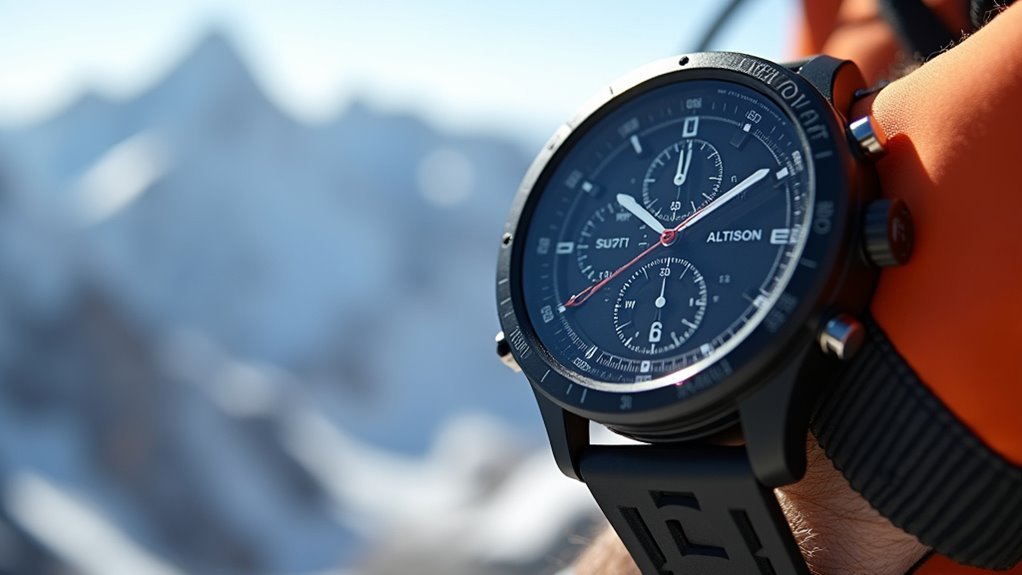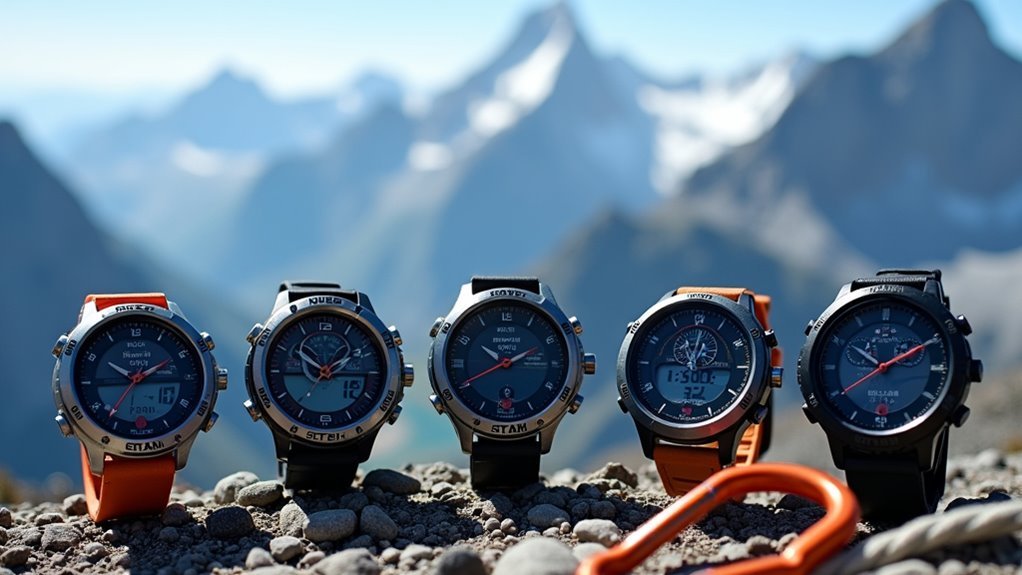You’ll want to evaluate the Garmin Fenix 8 series for thorough sensor integration and multi-band GPS precision, or the Garmin Instinct 2X Solar for unlimited battery life through solar power. The Suunto Core delivers year-long reliability with accurate barometric readings, while the Coros Pace 3 offers excellent value at $229 with GPS and ABC sensors. The Casio G-Shock Rangeman GW9400 combines solar charging with rugged durability for essential navigation tools that’ll guide you through challenging terrain and weather conditions ahead.
Essential Features Every Climbing Altimeter Watch Should Have

When you’re selecting an altimeter watch for climbing, certain core features will make the difference between a reliable companion and a frustrating liability on the mountain.
Your watch must include accurate altimeter functionality that measures elevation changes through atmospheric pressure readings. You’ll need integrated GPS for precise location tracking and a reliable compass for directional guidance when visibility’s poor.
Essential safety features include ascent/descent rate tracking to monitor your climbing pace and storm alerts that warn of sudden weather changes.
Your watch should withstand harsh conditions with scratch-resistant screens, water resistance, and durable materials that won’t fail when you need them most.
Long battery life prevents power failures during extended climbs, while backlighting guarantees readability in low-light conditions. The altimeter tracks your elevation changes in precise 3 ft. increments to help maintain accurate positioning throughout your climb.
How Barometric Pressure Sensors Enhance Mountain Safety
While you’re traversing treacherous mountain terrain, your altimeter watch’s barometric pressure sensor serves as an early warning system that can save your life. This technology converts air pressure readings into both altitude data and weather forecasts, monitoring continuous changes during your ascent or descent.
You’ll receive critical alerts when pressure drops suddenly, signaling approaching storms before visible signs appear. The sensor distinguishes between elevation changes and weather-related pressure shifts, ensuring accurate navigation despite fluctuating conditions. Rising readings indicate improving weather, while falling pressure warns of deteriorating conditions.
Your watch tracks historical data patterns, helping you predict weather trends over hours or days. This reduces your reliance on external weather reports in remote areas, enhancing situational awareness and supporting emergency planning when environmental instability threatens your safety. Regular periodic calibrations at known elevations maintain the sensor’s precision throughout your mountain expedition.
Top 5 Altimeter Watches for Professional Climbers

When you’re tackling challenging ascents, you need an altimeter watch that delivers elite features like precision GPS tracking, storm alerts, and elevation gain monitoring.
Professional-grade durability becomes essential as your watch must withstand extreme temperatures, moisture, and impacts while maintaining accurate readings throughout extended expeditions.
You’ll also want advanced navigation capabilities including route tracking, waypoint marking, and compass integration to safely navigate complex terrain and changing weather conditions. Models with solar charging technology can extend your battery life during multi-day climbing adventures when power sources are unavailable.
Elite Model Features
Professional climbers demand altimeter watches that deliver uncompromising accuracy, durability, and reliability in the world’s most challenging environments.
You’ll find these elite models pack essential features that separate them from recreational alternatives. Multi-band GNSS technology guarantees you’re getting precise positioning data when every meter counts. Solar charging capabilities extend your expedition time without worrying about battery depletion.
Titanium construction and sapphire glass provide the durability needed for technical ascents. Storm alert systems give you critical weather warnings, while barometric trend graphs help you predict changing conditions. ABC sensors deliver thorough environmental data at your fingertips.
Extended battery life ranging from 40 to 320 hours in GPS tracking mode ensures your watch performs throughout multi-day expeditions and technical climbs. Glove-friendly interfaces guarantee you can operate controls in harsh conditions. These premium features justify the investment when your safety depends on accurate altitude readings and reliable performance.
Professional Grade Durability
Since your altimeter watch becomes your lifeline during technical ascents, you can’t afford equipment failure when scaling vertical rock faces or maneuvering through whiteout conditions.
Professional-grade models like the Suunto Core and Casio Pro-Trek series deliver exceptional durability through robust materials engineered for extreme environments.
You’ll need water resistance that protects against rain and snow, plus scratch-resistant sapphire glass like the Coros Apex 2 offers. These watches withstand drops, impacts, and temperature extremes while maintaining accurate altimeter readings at high altitudes.
The Suunto Core’s year-long battery life guarantees reliability during extended expeditions. Modern altimeter watches utilize aneroid barometers to calculate altitude based on air pressure changes, providing precise readings essential for navigation in challenging terrain.
Professional climbers consistently choose models with glove-friendly interfaces and proven track records in harsh conditions, prioritizing function over aesthetics when their safety depends on precision.
Advanced Navigation Capabilities
Beyond durability, your altimeter watch must excel at wayfinding when you’re traversing unmarked routes or facing rapidly changing weather conditions.
The Garmin Fenix 8 Pro Solar delivers multi-band GPS with detailed topo maps and customizable route planning specifically designed for climbers.
You’ll appreciate the Coros Apex 2 Pro’s multi-GNSS systems that enhance satellite reception while providing touchscreen maps for advanced wayfinding modes.
The Garmin Forerunner 965 supports thorough route navigation with topographic maps and live tracking capabilities. Its AMOLED display enhances readability in challenging outdoor conditions where screen visibility is crucial.
Meanwhile, the Suunto Vertical Titanium offers storm alerts based on pressure trends, giving you essential weather safety information.
The Casio G-Shock Mudmaster provides reliable compass functions through its Triple Sensor technology, ensuring you won’t lose your bearing.
Garmin Instinct Series: Complete Review for Mountain Enthusiasts
You’ll find the Garmin Instinct Series stands out with its innovative solar charging technology that extends battery life during extended mountain expeditions.
The watch’s all-encompassing navigation features include GPS, GLONASS, and GALILEO satellite systems that work seamlessly with its built-in altimeter and 3-axis compass for precise positioning in challenging terrain.
These mountain-focused capabilities make it particularly valuable when you’re maneuvering through complex routes or tracking elevation changes during multi-day climbs. The continuous monitoring functionality ensures you receive real-time elevation data even when the watch operates in low-power mode, maintaining critical altitude tracking throughout your entire expedition.
Solar Charging Technology
Most climbers understand that reliable power is essential when you’re miles from the nearest electrical outlet, and the Garmin Instinct Solar addresses this challenge with integrated solar charging technology that can extend your watch’s battery life by up to 30 additional days under ideal conditions.
The solar panels are seamlessly built into the watch face, creating a sleek design while maximizing light exposure. You’ll find the technology works best outdoors where sunlight intensity is highest, though it’s less effective indoors due to reduced light levels.
The watch operates within 0°C to 60°C for solar charging and monitors solar intensity in real-time, helping you optimize charging efficiency. The solar panel features a larger surface area compared to other Garmin models, which contributes to higher power generation for extended outdoor expeditions.
Combined with smartwatch mode offering 24 days of standard battery life, you’re getting exceptional power management for extended mountain adventures.
Mountain Navigation Features
While extended battery life keeps your watch running during multi-day expeditions, the Garmin Instinct series delivers thorough mountain navigation capabilities that prove invaluable when you’re maneuvering through challenging terrain. You’ll benefit from multi-band satellite support that enhances GPS accuracy in mountainous environments, while built-in altimeter, barometer, and compass sensors provide essential data for altitude awareness and weather monitoring.
| Navigation Feature | Mountain Application |
|---|---|
| Point-to-Point Routing | Direct navigation between waypoints |
| Breadcrumb Trail | Visual path tracking in unfamiliar terrain |
| Back to Start | Emergency return navigation |
| TracBack | Route retracing capability |
| Elevation Profile | Real-time climb/descent progress |
The watch supports route loading for multiple trails and provides current position tracking with mini-compass functionality for off-course correction during your climbs. Navigation is handled through a non-touchscreen interface with five dedicated buttons, ensuring reliable operation even when wearing gloves or in challenging weather conditions.
Suunto Core Vs Competitors: Which Offers Better Altitude Tracking
When comparing altitude tracking capabilities, the Suunto Core stands out for its barometric-based approach, but it faces stiff competition from GPS-enabled alternatives like Garmin watches.
You’ll find the Core requires calibration at known reference points for accurate readings, while Garmin’s GPS system offers more straightforward operation. The Core tracks elevation changes of 3 meters or more, whereas Garmin records smaller 1-meter changes, making it superior for detailed elevation gain tracking across multiple climbs.
However, you’ll appreciate the Core’s reliability in remote areas where GPS signals weaken. Its single barometric sensor can produce inaccuracies during rapid pressure changes, but when properly calibrated, it delivers precise altitude readings. The Core’s impressive altitude range spans from -500m to +9000m, accommodating everything from below-sea-level locations to high-altitude mountaineering.
The Core’s rugged design and extensive feature set make it a solid value choice for serious climbers.
Battery Life Considerations for Extended Climbing Expeditions
Extended climbing expeditions demand altimeter watches that can operate reliably for days or weeks without access to charging stations.
You’ll need to prioritize models with exceptional battery longevity, like the Suunto Core, which delivers up to one year of battery life with its replaceable CR2032 lithium battery.
Solar-powered options from Garmin and Suunto offer unlimited battery life in sunny conditions, making them ideal for high-altitude climbs.
However, cold temperatures can reduce battery performance, so you should carry spare batteries for non-solar models.
Manage your watch’s power consumption by minimizing GPS and compass usage when unnecessary.
Traditional altimeter watches generally outlast GPS-enabled models, so consider your feature priorities carefully. Mechanical altimeters provide the ultimate battery solution since they operate without any power source requirements.
Power-saving modes and proper calibration help maximize battery efficiency during critical expeditions.
GPS Navigation Capabilities in Modern Altimeter Watches
Beyond power management, modern altimeter watches have revolutionized climbing navigation through sophisticated GPS capabilities that transform how you navigate challenging terrain. You’ll benefit from precise location tracking, route planning, and breadcrumb trails that help you find your way back safely. These watches support multiple satellite systems like GPS, GLONASS, and Galileo for enhanced accuracy, while waypoint marking lets you save important locations like campsites or trail junctions.
| Feature | Benefit |
|---|---|
| Multi-satellite support | Enhanced GPS accuracy in challenging terrain |
| Breadcrumb trails | Easy route backtracking for safety |
| Waypoint marking | Save critical locations for reference |
You can also integrate with smartphones and third-party apps for thorough data analysis and customizable maps tailored to your specific climbing routes. High-end GPS watches offer mapping features that provide detailed topographic information directly on your wrist for enhanced navigation capabilities.
Weather Prediction Features for High-Altitude Adventures
When you’re scaling peaks, your altimeter watch becomes a critical weather station on your wrist, delivering barometric pressure storm alerts that can mean the difference between safety and danger.
Modern climbing watches analyze atmospheric pressure changes to detect approaching storms hours before they hit, giving you precious time to seek shelter or adjust your route. These advanced timepieces achieve ±0.1 mb accuracy through precision barometric pressure sensors for reliable weather detection.
You’ll receive real-time weather forecasting that combines barometric data with temperature and humidity readings, transforming your timepiece into an early warning system for high-altitude conditions.
Barometric Pressure Storm Alerts
While ascending treacherous peaks, you’ll rely on your altimeter watch’s barometric pressure sensors to detect atmospheric changes that signal approaching storms. These dedicated sensors measure pressure in hectopascals and trigger alerts when detecting rapid drops—typically 2-3 hPa over three hours.
However, altitude changes complicate readings since climbing just 80 feet can trigger false storm alerts. Every 27 feet of elevation equals about 1 hPa pressure change, making weather detection challenging during ascents.
| Time Period | Altitude Gain | Recommended Action |
|---|---|---|
| 3 hours | 40-60 feet | Watch for lowering clouds |
| 3 hours | 60-80 feet | Consider bailing summit |
| 3 hours | Above 80 feet | Descend immediately |
| Overnight | 1000 feet | Severe storm conditions |
You’ll get best results by calibrating at known altitudes, adjusting sensitivity settings, and combining watch data with weather forecasts. For optimal accuracy, ensure outdoor calibration of your altimeter before beginning any climbing expedition to minimize environmental interference from indoor climate-controlled settings.
Real-Time Weather Forecasting
Storm alerts form just one piece of your altimeter watch’s weather arsenal—advanced models now deliver extensive real-time forecasting that transforms how you approach high-altitude climbing.
These watches integrate barometers, altimeters, and thermometers to provide detailed weather data through frequent sensor readings and predictive algorithms that analyze pressure trends over time.
You’ll receive high-resolution barometric pressure readings within 3-foot increments, enabling accurate short-term forecasts tailored to your immediate surroundings.
Advanced models incorporate GPS and digital compasses to correlate weather data with your precise location, enhancing situational awareness. The altimeter function’s foundation in atmospheric pressure changes allows these devices to detect shifting weather patterns as you ascend to different elevations.
Temperature readings help you adjust gear accordingly, while smartphone app integration syncs with broader weather models and satellite data for improved forecast accuracy during your climbs.
Durability and Build Quality: Watches That Survive Extreme Conditions
Although altimeter accuracy matters most to climbers, your watch won’t deliver reliable readings if it can’t survive the mountain’s punishment. High-end altimeter watches use sapphire crystal glass and titanium cases to resist scratches and corrosion.
You’ll find shock-resistant casings, water resistance ratings exceeding 100 meters, and screw-down crowns preventing water ingress. These watches endure extreme temperature swings, high altitudes, and prolonged UV exposure while maintaining accuracy.
Battery life becomes essential during multi-day expeditions. Non-GPS models last over a year, while GPS watches like the Garmin Fenix 7 Solar offer extended modes and solar charging. Many altimeter watches feature solar-powered technology to extend battery life during extended outdoor adventures.
Top durable options include the Coros Vertix 2 with titanium bezel, Suunto Race series, and shock-resistant Casio Rangeman with triple sensors.
Calibrating Your Altimeter Watch for Maximum Accuracy
Even the most rugged altimeter watch won’t help you navigate safely if its readings are off by hundreds of feet. Barometric altimeters require regular calibration since atmospheric pressure constantly shifts with weather changes.
Accurate elevation readings demand consistent calibration since atmospheric pressure changes can throw off altimeter measurements by hundreds of feet.
You’ll want to calibrate at known elevation points like trailheads before each climb, using verified markers for best accuracy. Your watch likely offers both manual input and GPS auto-calibration options in the sensor settings menu.
While GPS calibration works well in open areas with clear satellite access, manually entering known elevations proves more reliable. Recalibrate after weather changes or significant altitude shifts, as readings can drift 50-75 feet within 12 hours.
Some advanced watches offer continuous calibration throughout your activity, which provides periodic readings to reduce elevation fluctuations during extended climbs. Combine both methods when possible, and make sure sensor ports stay dry for peak barometric readings.
Budget-Friendly Altimeter Watches That Don’t Compromise Quality
When you’re shopping for an altimeter watch on a tight budget, you don’t have to sacrifice essential climbing features for affordability. The Coros Pace 3 delivers GPS tracking and ABC sensors for just $229, while the Suunto Core provides reliable barometric altitude readings with storm alerts for $299.
Even more budget-conscious climbers can consider the Casio SGW300HB-3AVCF, which features multiple sensors in a rugged design.
These watches maintain vital climbing functions like barometric altimeters, cumulative elevation tracking, and storm warnings. You’ll get long-lasting CR2032 batteries, water resistance, and durable construction that withstands harsh outdoor conditions. The Casio G-Shock Rangeman GW9400-3 stands out with its solar-powered operation and comprehensive feature set at an affordable price point.
While they may lack premium GPS features, these models offer the core altitude measurement and weather monitoring capabilities you need for safe climbing.
Advanced Sensors: Heart Rate Monitors and Temperature Tracking
Why settle for basic altitude readings when today’s advanced altimeter watches can monitor your body’s response to challenging climbs?
Modern altimeter watches integrate precision heart rate sensors using optical wrist-based technology, providing real-time feedback to help you manage pacing and safety. You’ll receive automatic alerts if your heart rate enters unsafe zones during ascents.
Temperature tracking capabilities use internal sensors to provide ambient readings, helping you prepare for hypothermia or heat stress risks. While watch surfaces aren’t always accurate for direct body temperature, they display temperature trends alongside elevation data for better situational awareness. Professional-grade models like the Garmin Fenix 8 series offer comprehensive sensor integration with prices ranging from $999.99 to $1199.99.
These multi-sensor systems create unified dashboards where heart rate, temperature, and elevation metrics work together, enabling informed decisions about rest, hydration, or route adjustments during your climbs.
Real-World Performance Testing at Different Elevation Levels
Three distinct elevation zones reveal dramatically different performance characteristics when testing altimeter watches in real climbing conditions. At lower elevations below 1000m, you’ll find Garmin and Apple watches deliver exceptional accuracy within 9 feet of official readings, while Samsung models can drift up to 261 feet off target.
| Brand | Low Elevation Error | High Elevation Notes |
|---|---|---|
| Garmin | ~9 ft | Most consistent across all ranges |
| Apple | ~9 ft | Good performance, slight decrease at altitude |
| COROS | ~34 ft | Improves with manual calibration |
| Samsung | ~261 ft | Requires frequent recalibration |
Mid-elevation ranges between 1000m-2500m show decreased accuracy as barometric pressure becomes less predictable. Above 2500m, you’ll need frequent recalibration at known reference points since pressure drops create larger measurement errors across all brands. Temperature variations significantly impact altimeter accuracy since cold air creates denser atmospheric conditions that affect pressure-to-altitude calculations.
Frequently Asked Questions
Can Altimeter Watches Work Underwater During River Crossings or Water Activities?
You can use altimeter watches during river crossings if they’re rated 5-10 ATM, but their altitude functions won’t work accurately underwater since water pressure overrides barometric readings needed for elevation measurements.
How Do Altitude Readings Change When Traveling by Airplane or Helicopter?
During flight, you’ll notice your altimeter readings become inaccurate due to rapid air pressure changes. You’ll need to recalibrate your watch after landing since atmospheric conditions shift markedly at high altitudes.
Are Altimeter Watches Compatible With Popular Climbing Apps and Fitness Platforms?
You’ll find altimeter watches sync well with fitness platforms like Strava and TrainingPeaks through Bluetooth, but climbing-specific apps rarely offer direct integration—you’ll typically need to import data manually through branded platforms.
What Maintenance Schedule Should Climbers Follow for Optimal Altimeter Watch Performance?
You should calibrate your altimeter weekly during active climbing, replace batteries annually, clean after each expedition, and update firmware monthly. Always carry spare CR2032 batteries and calibrate before major climbs.
Do Altimeter Watches Affect Pacemaker Function or Other Medical Devices?
You don’t need to worry about altimeter watches affecting your pacemaker or medical devices. They emit extremely low electromagnetic signals that won’t interfere with implanted devices during climbing activities.
In Summary
You’ve now got the essential knowledge to choose an altimeter watch that’ll keep you safe and informed on your climbs. Whether you’re investing in a premium Garmin or Suunto model or starting with a budget-friendly option, remember that accurate calibration and understanding your watch’s sensors are vital. Don’t just rely on technology alone—always combine your altimeter readings with weather awareness and traditional navigation skills for the safest climbing experience.





Leave a Reply